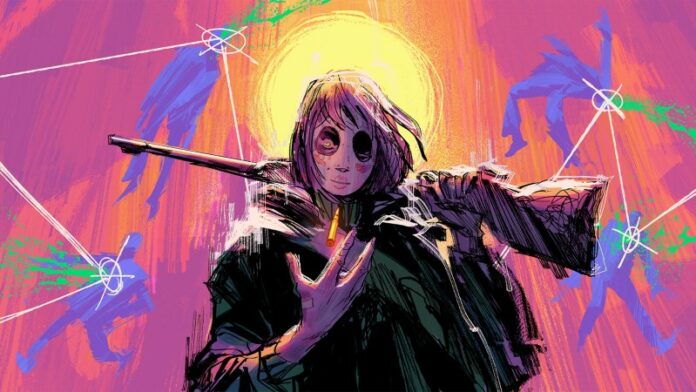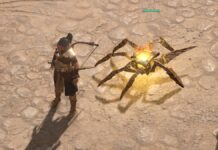Children of the Sun is hellbent on occupying your mind. During the six hours it took me to hit credits, I was engrossed in mastering its simple, yet wonderfully executed central mechanic. At first, taking down dozens of cultists with just one bullet was a fun gimmick to tinker with. As time passed, I became obsessed with pushing the tools at my disposal to their limits, repeatedly using people as target practice until I had concocted a satisfactory murder plan.
Introduced as a puzzle shooter, Children of the Sun has you incarnating a young woman who lost her family after getting involved with the eerie namesake cult. Using just one bullet of your sniper rifle, you plunge through over 20 levels by connecting kills until you take everybody down in one swift sequence. As you make progress, the foundation gains complexity with special foes that require different strategies, as well as a handful of abilities around the bullet itself.
It’s easy to see the influences from the likes of Killer7, Sniper Elite, and the latter Hitman games. But there are echoes of Ghost Trick: Phantom Detective as well, infusing inanimate objects with a paranormal force to interact with the environment, and people’s bodies, to your advantage.
At the start of a level, you only get a narrow view of the whole map, so to speak. Ideally, you want to tag every single cultist before pulling the trigger, so you can plan ahead of time – similar to scanning a room in Hotline Miami before kicking down the door. More often than not, you first need to kill a few of them just to tag others or get a better view at the far end of an area. It makes for a compelling exploratory phase that doesn’t frustrate but rather encourages you to fail until you’ve gathered all the visual information you need.
Time slows down when you’re moving the bullet. It also completely stops once you hit a target. This gives you some breathing room, and a chance to gain a different perspective. You can shoot birds to gain altitude or gas tanks to find an angle that allows you to continue chaining down targets, for example. Yet, you’re rewarded via a scoring system for executing a killing with style and aggressiveness. It works as the perfect contrast to the exploratory phase, forcing you to see whether your plan can be executed swiftly or if you need another strategy. There’s a leaderboard at the end of each level that incentivizes you to push for this cruel finesse, as well as vague clues for challenges to uncover.
The macabre tone of Children of the Sun pairs well with its human gamification. Shooting an arm gives you 25 points. Shooting a groin rewards 50 points instead. The over-the-top violence turns gratuitous after seeing the words “I Just Killed a Man, Now I’m Horny” before playing a Pac-Man-style minigame during a special level. The abrasive tone never comes off as mere window dressing for the sake of shock value but rather thrives in its repulsiveness.
Both the visual and sound design work make for a haunting sensorial stimulation. There were times when I felt underwater, zip-zapping from one corner of an ocean to the next as the bullet pierced head after head, like waves colliding against each other. The effect of a late-game ability, which allows you to increase the speed of a shot, sounds like an electric guitar distorted to the brim with effect pedals.
Children of the Sun is a prime example of an experience born from a straightforward premise and then iterated for the right amount of time before it loses its charm. On occasion, the central mechanic can’t keep up with itself – I missed more than a few finicky shots that should have landed, forcing a retry. But once you successfully execute a strategy and finish a level, the satisfaction is unmatched. You then seek to replicate the feeling during subsequent hunts, completely alienated from the messiness of your actions as you chase a higher score.
www.gameinformer.com







